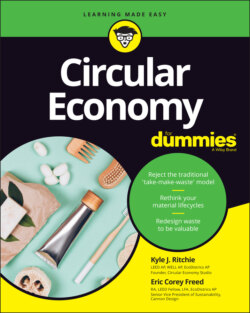Читать книгу Circular Economy For Dummies - Eric Corey Freed - Страница 100
Takes a lickin’ and keeps on tickin’
Оглавление“They don’t make ’em like they used to.” Raise your hand if a grandparent shouted out that phrase every time a car or an appliance (or even you, when you somehow managed to strike out during T-ball) didn’t perform as expected. Although it’s a phrase we commonly use to mock older generations, unfortunately it’s incredibly accurate. Products are no longer designed and manufactured to last, and durability is rarely a performance priority for common products like plasticware. If you had a dollar for every plastic fork you have broken, you’d have enough to buy an actual silverware set. Though some products — like the plastic fork — are designed to be extremely cheap to make in order to maximize revenue, for other products, the lack of durability is deliberately a leading design influence. When you design products that can’t last, they won’t last and you’ll find yourself in a position where buying another one is the only option you have available. If products were built to last, what reason would the consumer have for acting as a repeat customer? They wouldn’t have one.
Designing a product that’s built to last — like Ford claims its vehicles are — will lead to happy clients, but designing a product with planned obsolescence built right into the product will lead to repeat clients if they lack better options to choose from. Planned obsolescence is the act of intentionally designing a product to have a limited lifespan and/or manufacturing a product that will eventually fail. There are many reasons a company would decide to minimize the durability of a product and instead focus on limiting its lifespan; here are a few examples:
The materials used to make the product are extremely cheap and allow the company to make a larger profit.
Tech support and spare parts may be made available for only a limited time and are eventually withdrawn for last year’s model.
The product might be updated with new features and technology that leave the customer with no choice but to purchase an upgraded product. One example is Apple and its infamous iPhone “Batterygate.” Apple found itself on the receiving end of public outrage when it revealed that the phone’s batteries had been designed to slow down as they aged. Apple claimed that this strategy was implemented as a means to preserve battery life, but customers weren’t satisfied with that answer. Because of this setting, Apple customers were indirectly forced to upgrade their phones to newer versions in order to maintain a high level of performance. Now, if users had been in a position to replace the battery themselves, this wouldn’t have been an issue. Unfortunately for the user, iPhone batteries can be changed only by Apple. This isn’t the only situation where the company has utilized planned obsolescence as a business strategy: The company’s sudden switch to the lightning charger made older-style chargers obsolete, which meant that if you bought a new phone, you also had to buy a new charger.
There’s no question why businesses choose to leverage the money-making abilities of planned obsolescence. Repeat business drives in the big bucks, and as long as you give the customer an enjoyable experience with a product, when that product fails, the customer will more than likely buy from the same company again because it’s familiar to them. But, unfortunately, the world is at the point where change needs to happen and the global economy needs to support products designed to be durable and to produce no waste, that can be repaired and used over and over again, and that can be controlled by their owners. The global economy needs to support products that can be rented rather than owned, remanufactured to be made new again, made available for those with low incomes, and constructed with materials that can be easily reintroduced into materials flows and made into new products. The circular economy can facilitate the development of this reality, but are companies and consumers aware of the value attached? Well, not all, but some do.
